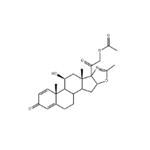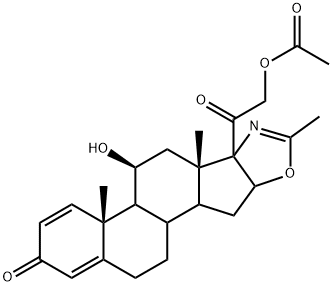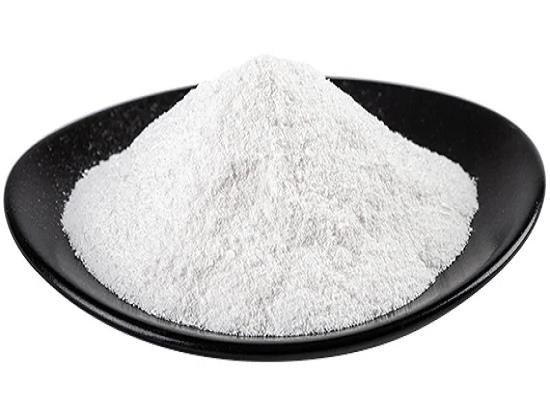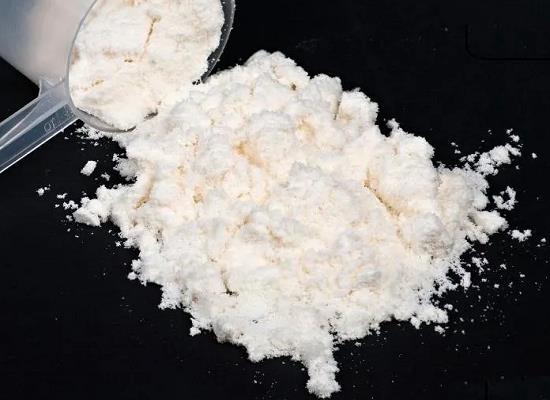Deflazacort: A Glucocorticoid Prodrug for the Treatment of Duchenne Muscular Dystrophy
General Description
Deflazacort is a glucocorticoid prodrug used to treat Duchenne muscular dystrophy (DMD). It inhibits cytokine release and suppresses CD4+ lymphocyte proliferation, leading to anti-inflammatory and immunosuppressive effects. The exact mechanism of action in DMD is not fully understood, but it may enhance muscle cell proliferation, inhibit muscle breakdown, and modify the expression of crucial proteins like dystrophin. Deflazacort is orally administered and converted to an active metabolite, which is then metabolized by CYP3A4 enzymes. Absorption is relatively quick, unaffected by renal impairment, and slightly affected by high-fat meals. Safety considerations include potential adverse effects such as cushingoid appearance and growth delay, as well as interactions with CYP3A4 inhibitors and neuromuscular blocking drugs.

Figure 1. Deflazacort
Pharmacology
Deflazacort is a glucocorticoid prodrug that undergoes conversion to its active metabolite, 21-desacetyldeflazacort. This medication has been found to inhibit the release of cytokines by suppressing the proliferation of peripheral blood cells, particularly CD4+ lymphocytes. As a result, there is a reduction in CD4+ cells, but an increase in CD8+ cells, leading to anti-inflammatory and immunosuppressive effects within the body. Although the exact mechanism of action of deflazacort in Duchenne muscular dystrophy is still not fully understood, it is believed to have multiple effects. Firstly, it may enhance muscle cell proliferation, which can contribute to an overall increase in muscle mass. Additionally, deflazacort may inhibit muscle breakdown, thereby preserving muscle function. Furthermore, it is thought that deflazacort may act as a transcription modifier for proteins such as dystrophin, which plays a crucial role in muscle function. By modifying the expression of these proteins, deflazacort may help improve muscle function and potentially slow down the progression of DMD. 1
Pharmacokinetics
Deflazacort is an oral prodrug that is enzymatically converted to an active metabolite, 21-desacetyldeflazacort, which is then metabolized by cytochrome P450 3A4 (CYP3A4) enzymes to inactive metabolites. This drug is administered as a tablet or oral suspension, and both dosage forms display similar bioavailability. Absorption occurs relatively quickly, with a Tmax of about 1 hour, and is not affected by renal impairment or moderate hepatic impairment. However, high-fat meals can delay the Tmax by 1 hour and decrease Cmax by 30%. The half-life of 21-desacetyldeflazacort is 1.9 hours, and approximately 68% of deflazacort is eliminated through urinary excretion within 24 hours, with 18% represented by the active metabolite. The drug exposure profile in pediatric and adolescent patients varies slightly, with higher Cmax and AUCinf values in adolescents aged 12 to 16 years old compared to children aged 4 to 11 years old after a dose of 0.9 mg/kg. It is important to note that deflazacort should be used with caution in patients with severe hepatic impairment, as there are currently no data on how drug exposure is affected in this population. Regular monitoring of liver function tests is recommended during treatment with deflazacort. 2
Safety
Deflazacort is a medication used for the treatment of Duchenne muscular dystrophy, but it is important to consider its safety profile before administering it to patients, especially young children. Glucocorticoids, the class of drugs to which deflazacort belongs, are known to have a wide range of adverse effects. When compared to prednisolone, another glucocorticoid, patients taking daily doses of deflazacort were found to have a greater risk of cushingoid appearance, growth delay, and cataracts. However, the mean weight gain was significantly less in patients taking deflazacort compared to those taking prednisolone, and incidences of hirsutism were also lower. It is also important to consider potential interactions between deflazacort and other medications. Deflazacort is metabolized by an enzyme called CYP3A4, and drugs that inhibit or induce this enzyme can affect its efficacy. It is recommended to reduce the deflazacort dose when co-administering it with moderate or strong CYP3A4 inhibitors. Conversely, CYP3A4 inducers should be avoided as they can decrease deflazacort exposure. Additionally, deflazacort should not be taken with neuromuscular blocking drugs like pancuronium due to an increased risk of acute myopathy. In conclusion, while deflazacort is an effective treatment for DMD, caregivers should be aware of its potential adverse effects, impact on immunization, and interactions with other medications. 3
Reference
1. Angelini C, Peterle E. Old and new therapeutic developments in steroid treatment in Duchenne muscular dystrophy. Acta Myol. 2012;31:9-15.
2. Bylo M, Farewell R, Coppenrath VA, Yogaratnam D. A Review of Deflazacort for Patients With Duchenne Muscular Dystrophy. Ann Pharmacother. 2020;54(8):788-794.
3. Emflaza [package insert]. South Plainfield, NJ: PTC Therapeutics; 2019.
);You may like
Related articles And Qustion
Lastest Price from Deflazacort manufacturers

US $0.00/KG2024-03-16
- CAS:
- 14484-47-0
- Min. Order:
- 100g
- Purity:
- 98%+
- Supply Ability:
- 100kg

US $1840.00/kg2023-11-27
- CAS:
- 14484-47-0
- Min. Order:
- 0.1kg
- Purity:
- 99% HPLC
- Supply Ability:
- 20 tons



